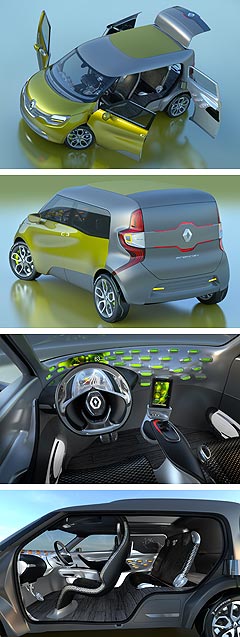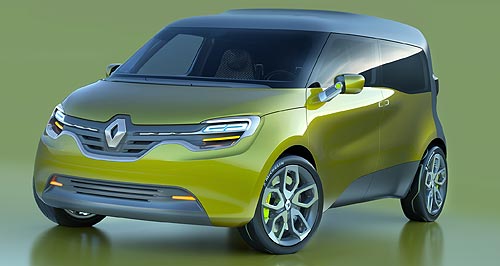Future models - Renault - FrendzyFrankfurt show: Renault to reveal Frendzy of EVsNew communication: The passenger-side sliding door of the Frendzy incorporates a 37-inch (94cm) widescreen that can display a company logo or various messages. Radical Frendzy EV concept could preview next Kangoo van at Frankfurt show8 Jul 2011 RENAULT has signalled its light commercial future with the radical Frendzy concept, which has been unveiled months ahead of its debut at September’s Frankfurt motor show. The concept is said to represent the ‘world of work’ stage of Renault’s life-cycle inspired design strategy, which began with the scissor-doored DeZir coupe concept at last year’s Paris motor show. The curvaceous DeZir represented the idea of ‘love at first sight’, while the Captur crossover and R-Space MPV concepts from the most recent Geneva show were inspired by the ‘discovering the world’ and ‘establishment of a family’ stages of life respectively. Sharing a similar nose treatment and wave-like body contours with those concept models, the Frendzy is equally striking, with voluptuous curves and a sparse, high-tech interior. Renault - which is Europe’s biggest seller of LCVs - says the Frendzy is intended to be a commercial business vehicle that doubles up as a passenger vehicle when required. “Frendzy is the must-have vehicle for flexibility and versatility. It is efficient and modern as a work tool, yet sporting and warmly welcoming for the family,” said Axel Braun, Renault’s design director for concept and show cars. The exterior of the concept has an unusual layout - the driver’s side features two pillar-less, centre-opening doors, while the passenger side’s conventional front door is joined by a commercial van-style sliding side-door.  The car’s exterior designer, Deyan Denkov, said this strangely-configured, snub-nosed design was partly inspired by unconventionally shaped aircraft like the Airbus Beluga and Antonov 224. The car’s exterior designer, Deyan Denkov, said this strangely-configured, snub-nosed design was partly inspired by unconventionally shaped aircraft like the Airbus Beluga and Antonov 224."The concept of an asymmetric body design was the most logical way to express this vehicle’s two roles,” he said. “From the very start, I wanted to move away from the traditional format for commercial vehicles and, in doing so, show that this type of vehicle could also be more emotional, more dynamic and more attractive.” The passenger-side sliding door also incorporates a 37-inch (94cm) widescreen that can display a company logo or various messages, such as “making deliveries”, while parked or driving. The dimensions of the Frendzy concept are very similar to the current-generation Kangoo short-wheelbase, in terms of width (2172mm), height (1743mm) and wheelbase (2691mm). The concept’s stubby front and rear overhangs mean the van is around 120mm shorter than the Kangoo. Rear carrying capacity is a voluminous 2250 litres, while the futuristic van is a relative lightweight, tipping the scales at 1420kg. The similarities with Kangoo continue under the hood, with the Frendzy being powered by the electric motor from the ZE variant of Renault’s popular LCV. The 44kW/226Nm synchronous electric motor, which is powered by a 22kWh lithium-ion battery pack, is claimed to propel the concept to a top speed of 130km/h. Different to the Kangoo ZE, however, is the location of the charging point, which is located under the badge at the front of the car - much like the Nissan Leaf and Renault’s own Zoe EV concept first seen at the 2009 Frankfurt show. Inside, the Frendzy has been designed to be an office on wheels, with a plugged-in tablet computer replacing the traditional instrument fascia that can also be detached and used as a regular tablet. The computer also controls the exterior screen on the side of the vehicle – when either moving or parked – while sensors in the door sills can log the loading and unloading of packages that contain radio frequency ID chips. These chips contain information such as the address of destination, weight and dimensions, which can give a user real-time inventory on their cargo. In-built tablet computers are something of a trend at motor shows this year, with concept vehicles such as the Volkswagen Bulli and Rinspeed BamBoo adopting similar set-ups at the Geneva show and the Volvo Concept Universe doing likewise at Auto Shanghai in April. When carrying passengers, the rear bench seat folds out from the floor, while entertainment comes in the form of a tablet PC that slides out from behind the driver’s seat and a slate integrated into the sliding door that children can draw on. When in ‘work’ mode, the rear-view mirror sits in an upright position, while a myriad of lighting pods glow a bright shade of green. In ‘family’ mode, the rear-view mirrors move to a horizontal position to give a better view behind the front seats and the interior lights turn warm orange. The French car-maker has also continued its collaboration with the Institut deRecherche et Coordination Acoustique / Musique (IRCAM) to customise the artificial sounds produced by the naturally silent electric powertrain – much like it did with the DeZir. The sounds, which are added for safety reasons, are said to vary both inside and outside of the cabin depending on the force of acceleration and deceleration. “Exploring the most informative sounds possible led me to work on variations in speed in order to express them in a clear manner,” said IRCAM composer Andrea Cera. “When accelerating hard, the sound becomes sharper, with a little wind noise. For deceleration phases, I added a more prominent notion of wind which provides greater scope for adapting the sound as a function of how the vehicle is being employed.” Somewhat cryptically, Renault also claims that it is possible to tell whether the car is in ‘business’ or ‘passenger’ mode simply by its sound signature.  Read more2nd of March 2011  Geneva show: Renault's sporty R-Space MPV conceptRenault R-Space concept gives possible glimpse at next-gen ScenicAll future models Alfa Romeo Alfa Romeo Abarth Abarth Audi Audi Aston Martin Aston Martin BMW BMW Bentley Bentley Chrysler Chrysler Chevrolet Chevrolet Dodge Dodge Citroen Citroen Ferrari Ferrari DS DS Ford Ford Fiat Fiat FPV FPV Foton Foton Haval Haval Great Wall Great Wall Honda Honda Holden Holden Hyundai Hyundai HSV HSV Isuzu Isuzu Infiniti Infiniti Jeep Jeep Jaguar Jaguar Lamborghini Lamborghini Kia Kia Lexus Lexus Land Rover Land Rover Mazda Mazda Maserati Maserati Mercedes-Benz Mercedes-Benz McLaren McLaren Mini Mini Nissan Nissan Mitsubishi Mitsubishi Peugeot Peugeot Opel Opel Proton Proton Porsche Porsche Renault Renault Ram Ram Saab Saab Rolls-Royce Rolls-Royce Smart Smart Skoda Skoda Subaru Subaru SsangYong SsangYong Tesla Tesla Suzuki Suzuki Toyota Toyota Volvo VolvoMotor industry news |
Click to shareRenault modelsResearch Renault All future models Alfa Romeo Alfa Romeo Abarth Abarth Audi Audi Aston Martin Aston Martin BMW BMW Bentley Bentley Chrysler Chrysler Chevrolet Chevrolet Dodge Dodge Citroen Citroen Ferrari Ferrari DS DS Ford Ford Fiat Fiat FPV FPV Foton Foton Haval Haval Great Wall Great Wall Honda Honda Holden Holden Hyundai Hyundai HSV HSV Isuzu Isuzu Infiniti Infiniti Jeep Jeep Jaguar Jaguar Lamborghini Lamborghini Kia Kia Lexus Lexus Land Rover Land Rover Mazda Mazda Maserati Maserati Mercedes-Benz Mercedes-Benz McLaren McLaren Mini Mini Nissan Nissan Mitsubishi Mitsubishi Peugeot Peugeot Opel Opel Proton Proton Porsche Porsche Renault Renault Ram Ram Saab Saab Rolls-Royce Rolls-Royce Smart Smart Skoda Skoda Subaru Subaru SsangYong SsangYong Tesla Tesla Suzuki Suzuki Toyota Toyota Volvo VolvoMotor industry news |
















Facebook Twitter Instagram